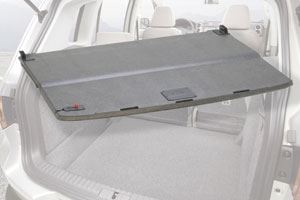Tough sandwich design lightens load floor in crossover SUV
Volkswagen’s new 2009 Tiguan crossover sport utility vehicle — the name is a cross between tiger and iguana — aims to please a wide range of customers with power and economy. Based on Volkswagen’s Golf platform, Tiguan has lightweight components in many areas, including the load floor, the flat panel behind
Volkswagen’s new 2009 Tiguan crossover sport utility vehicle — the name is a cross between tiger and iguana — aims to please a wide range of customers with power and economy. Based on Volkswagen’s Golf platform, Tiguan has lightweight components in many areas, including the load floor, the flat panel behind the back seats that supports luggage and gear while hiding the spare tire. This part, which must bear relatively high loads without excessive deformation, is a stiff yet light sandwich, comprising a Kraft paper honeycomb core and fiberglass mat skins covered with a lightweight decorative carpet. Sprayable Baypreg F polyurethane (PU) resin, supplied by Bayer MaterialScience AG (Leverkusen, Germany), bonds the sandwich components together.
The load floors are fabricated by Ideal Automotive GmbH (Bamberg, Germany) using a semi-automated process called Polyurethane Resin Composite Spray Molding (PUR-CSM), developed by Hennecke GmbH (Sankt Augustin, Germany), a Bayer MaterialScience company. In the CSM process, a preform is first created by pulling the glass mat materials, top and bottom, over the paper honeycomb core, which has been cut to rough size. (According to Hennecke, any type of core can be used, including foam, metal or plastic.) An articulated robotic arm grips the preform and moves it back and forth under a stationary spray nozzle, which wets out the material package on both sides with Baypreg F resin. Baypreg F is a two-component PU formulated specifically for automotive interior parts, with high heat resistance and a coefficient of thermal expansion (CTE) similar to aluminum and steel. The robot then places the wetted preform into a heated compression mold. The load floor part is crush molded at 130°C/266°F for approximately 45 to 90 seconds. The heated mold triggers the cure reaction of the PU resin, says Karsten Müller, a polyurethane composites specialist at Bayer MaterialScience: “We can obtain stiff and strong components weighing less than 3 kg [6.6 lb] per square meter, which are up to 80 percent lighter than corresponding parts of traditional materials, such as sheet metal.”
Demolded parts are trimmed and finished with the decorative covering and fasteners. The finished load floor is 80 cm long by 1m wide by 2 cm thick (32 inches by 39 inches by 0.8 inch). It exhibits very high flexural strength, thanks to the approximate 50 percent glass reinforcement loading in the skins and a modulus of elasticity of approximately 13,000 MPa.
Related Content
-
COMPINNOV TP2 project promotes use of thermoplastics in aerospace
Completed in 2023, COMPINNOV TP2 explored thermoplastic composites, enhancing the understanding between prepregs and production methods to foster the potential for French aerospace innovation.
-
CompPair adds swift prepreg line to HealTech Standard product family
The HealTech Standard product family from CompPair has been expanded with the addition of CS02, a swift prepreg line.
-
Bladder-assisted compression molding derivative produces complex, autoclave-quality automotive parts
HP Composites’ AirPower technology enables high-rate CFRP roof production with 50% energy savings for the Maserati MC20.














